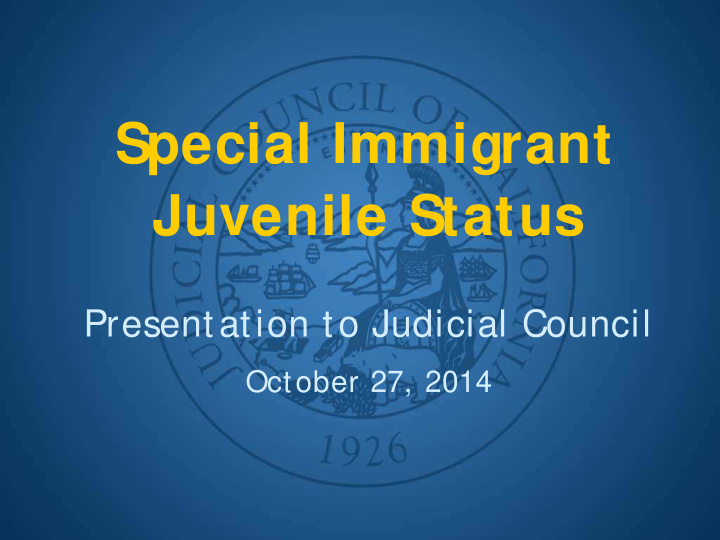



Special Immigrant Juvenile Status Presentation to Judicial Council October 27, 2014
Why Current Focus? • Recent surge in unaccompanied children crossing the southwestern U.S . border. • From 6775 in FY 2011 to 68,541 FY 2014 ending 9/ 30/ 14 • 45,029 children released to sponsors (adult relatives, family members, friends) from Jan. to S ept. 2014 • 4905 in California, most in LA and Bay Area
Children’s Country of Origin • El S alvador: 16,404 (24% ) • Guatemala: 17,057 (25% ) • Honduras: 18,244 (26.5% ) • Mexico: 15,634 (23% ) • Other: 1202 (1.5% ) Ent ire surge at t ribut able t o immigrant s from El S alvador, Guat emala, and Honduras
Special Immigrant Juvenile Status (SIJS) • A form of federal humanitarian relief for immigrant children who have been abused, neglected, or abandoned • Created by Congress in 1990; amended in 2008. • Three-step federal process • S uccess at each step required
Overview of SIJS Process 1: Request predicate findings from state court 2: Petition US Citizenship & Immigration S ervices (US CIS ) for classificat ion as S IJ 3: Remain in U.S . and apply to US CIS for lawful permanent resident (LPR) status
A Typical Arrival in the U.S. • Detained by U.S . Customs and Border Protection (CBP) • Transferred to custody of U.S . DHHS Office of Refugee Resettlement (ORR) • Placed in temporary shelter • Released to sponsor or placed in foster care
Total Children Released from ORR Custody to Sponsors in CA, Jan. 1 to Sept. 30, 2014 • S tatewide 4905 Los Angeles County 2474 • Alameda County 305 • Orange County 251 • S an Francisco County 223 • S an Mateo County 201 • S anta Clara County 170 • Riverside County 163 • S an Bernardino County 125 • Contra Costa County 120 • Other 873 •
Senate Bill 873 S igned S ept ember 27, 2014; effect ive immediat ely • • Codifies superior court j urisdiction to make S IJS predicate findings • Imposes duty to make findings if supported by evidence • Incorporates language of findings from federal law
other provisions SB 873— Evidence in support of S IJ findings may consist of • declaration of child seeking the findings Records of proceedings to request findings • confidential and sealable Court interpreters available per current law and • policy Judicial Council shall adopt rules and forms needed • to implement CDS S authorized to contract for provision of legal • representation to children in ORR custody
“Juvenile court”? • For S IJS purposes, a “ j uvenile court” is “ a court in the United S tates having j urisdiction under S tate law to make j udicial determinations about the care and custody” of children. • 8 C.F.R. § 204.11(a)
“Juvenile court” • S B 873 clarifies that • The superior court is a court of general j urisdiction • The family, probate, and j uvenile court divisions make determinations about the care and custody of children • Therefore, these divisions, at least, may make the S IJ findings in response to a proper request
SIJ Predicate Findings 1. The child has been a. Declared a dependent of the court OR b. Legally committed to or placed under the custody of i. A state agency or department OR ii. An individual or entity appointed by the court
SIJ Predicate Findings Reunification of the child 2. a. With one or both parents b. Is not viable because of Abuse i. Neglect ii. iii. Abandonment iv. A similar basis under California law
SIJ Predicate Findings 3. It has been determined in administrative or j udicial proceedings that it would not be not in the child’ s best interest to be returned to the child’ s, or his or her parent’ s, previous country of nationality or country of last habitual residence
Issues • Subject matter jurisdiction (UCCJEA; underlying state law actions) Effect of temporary emergency jurisdiction and orders • • Personal jurisdiction (notice, service of process, Hague Convention on Service Abroad, Inter-American Convention on Letters Rogatory) • Hearings and quantum of evidence • Confidentiality
Resources 1. Immigrat ion Considerat ions in Juvenile Court Video 2. Guardianship Roundtable, 2014 Advanced Issues in Probate and Mental Health Program, materials available at CJER Online 3. Memorandum distributed to PJs and CEOs 4. Materials available on California Dependency Online Guide (CalDOG) website 5. S IJS web page on Online S elf -Help Cent er in English and S panish
Next Steps Advisory committees coordinate to draft and 1. circulate proposed rules and forms, for recommendation to the Judicial Council, to facilitate request, j udicial inquiry, and determination CJER staff include S IJS as topic in Primary 2. Assignment Orientations and Institutes for Probate, Family, and Juvenile Law CFCC staff develop S IJS -focused educational 3. programs, webinars, and materials Monitor workload impact on trial courts; seek 4. additional resources if needed
Recommend
More recommend